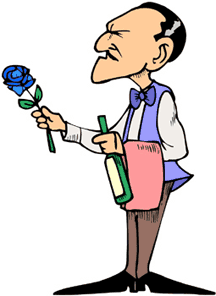
Blue roses: The race is on!
And an inside look into the not-so-clean,
flower industry...
By Marion Owen, Fearless Weeder
for PlanTea, Inc. and
Co-author of Chicken Soup for the Gardener's Soul
FEATURE ARTICLE:

Tom Hanks' "Power of Four" solution
More good stuff:
Who is Marion Owen?
FAQs about PlanTea
Search Marion's articles, tips and recipes
Why grow organic?
News and press releases
Read love letters
How to link to this site
Need a speaker?
How to contact Marion
Visiting Alaska?
Come to Kodiak Island!
Go to home page

Marion's UpBeet Gardener
Newsletter has been
replaced by Marion's blog
which you can find at:
www.marionowen.wordpress.com

Roses are red, violets are blue. But what if roses were blue? In that case, florists might make a lot of green.
Scientists are now closing in on a prize that has obsessed rose lovers for centuries -- the creation of the true blue rose.
The flower doesn’t exist in nature, and despite centuries of effort, no breeder has managed to even come close. They have called many roses blue Blue Girl, Rhabsody in Blue, Blue Moon… Trouble is, they're purple.
Because blue pigment does not exist in roses, like it does in forget-me-nots or blue poppies, the only way to create a blue rose is to manipulate its genetic code. And millions of dollars are being spent on the effort by genetic engineering companies.
The prize is a nice chunk of the $25 billion global cut-flower market, which hasn't seen a major twist in roses since the introduction of yellow around the turn of the last century.
To create blue, the Western world's most popular color, scientists have plucked genes from blue petunias, fiddled with indigo-producing enzymes from the human liver and tapped into the mystery of King George III's occasionally blue urine. (A story in itself.)
So far.. they've come up with some really nice purples.
Yet even if scientists did come up with a truly blue rose, challenges remain before calling it good. Like any other flower destined for the vase, the blue rose must hold up during shipment, last a long time in the vase and have a good fragrance. What do you think a blue rose should smell like? Email me your blue-rose-nose preference.
[From Anza Van Wyk, in Cape Town, South Africa: "A Blue rose should have a soft and lady like smell. Gentle and soft." Almost like the flower that doesn't want you to put it down."]
Now, for another look into the cut flower industry. One you might not know about, but should think about the next time you buy a bouquet of flowers...

Poisoned Petals: What you need to know about fresh cut flowers
Several years ago, I chatted with a lady who, for years, owned her own florist shop. She finally had to quit the business because her hands had become so chapped and red -- not from the water, but from handling flowers. Just to open and close her fingers was painful. (You might want to read my article on how to keep cut flowers looking fresh, organically).
 Thing is, to raise beautiful red roses and other flawless flowers in controlled
environments, many greenhouses rely on large quantities of pesticides. In fact, more
than half of all cut flowers sold in the United States are imported from
countries that have fewer restrictions on pesticide use.
Thing is, to raise beautiful red roses and other flawless flowers in controlled
environments, many greenhouses rely on large quantities of pesticides. In fact, more
than half of all cut flowers sold in the United States are imported from
countries that have fewer restrictions on pesticide use.
But even flowers grown in the states have been found to be contaminated with pesticide residues. California-grown roses were found to have 1,000 times the level of cancer-causing pesticides as comparable food products, according to a Environmental Working Group study.
Today's fresh-cut-flower industry has blossomed into a multibillion-dollar business, producing more than 100 million flowers every year, the industry isn't all so rosy. While floriculture work has opened up employment opportunities for about 190,0000 people in countries like Colombia, Mexico, and India, pesticide use (including those banned or restricted in the United States, like DDT) in huge greenhouses, where they process tons of flowers each year, threatens worker health and safety, jeopardizes the environment and could impact consumer health.
![]()
Why do imported flowers still carry pesticides on them?
Statistics on pesticide use in the industry are hard to obtain, but it is common knowledge that flower growers use a variety of fertilizers, insecticides, fungicides, nematocides and plant growth regulators. In the U.S., flower imports are not inspected for pesticide residues because they are not edible; however, since flowers are considered an agricultural product, they must be pest-free when imported. As a result, trade regulations in countries like the U.S. and Japan actually promote use of the highly toxic fumigant methyl bromide, a potent ozone depleter, for some flower imports.
![]()
We all live downstream
When you purchase (or receive!) a lovely bouquet of flowers from a florist, the flowers that make up the arrangement have traveled an average distance of 1,500 miles. So what? Well, consider this: According to the Regional Wildlife Management Program of the National University of Costa Rica, every three hours, one 35-ton cargo plane departs Colombia, jetting flowers around the globe.
![]()
What is being done?
To address these issues, many groups in Europe are rallying around worker and eco-rights in their own flower-power movement. At this writing, in the U.S., the Rainforest Alliance is developing floriculture standards that would prohibit use of chemicals banned by the U. S. Environmental Protection Agency, the European Union, and the U.N. Food and Agricultural Organization. (Source: "The Bloom on the Rose, Looking Into the Floriculture Industry," Environmental Health Perspectives, May 2002.)
![]()
What YOU can do
Whenever you inhale the scent of [non-organic] flowers, you are taking in more than sweet perfume. You are likely touching or inhaling poisonous chemicals. When you buy organic flowers, you won't have to worry about chemicals on your flower bouquets being toxic to your children, other members of your family, or yourself.
- Buying organic flowers helps support local organic farming communities and organizations.
- Organic flowers, according to many people, last longer than non-organic ones.On a spiritual, holistic level, organic flowers have been raised in ways so they retain the natural essence of flowers.
- Organic flowers are a natural part of a healthy, natural lifestyle.
Finally, please remember that every flower, every buying decision you make, counts. You vote with your money.I welcome you comments about this article. Marion Owen

Thanks for visiting and please stop by again. I'll put the coffee on!
Meet Marion Owen /// Learn about PlanTea /// Online Catalog /// Articles, Tips, Recipes /// Get free UpBeet Gardener newsletter /// Read current issue /// Listen to radio show /// Read news and press releases /// More resources and links /// Learn why 'grow organic?' /// View guidelines for retailers /// Read love letters /// Book Marion as a speaker /// Site map /// How to link to us /// Contact us /// Go to home page
PlanTea: The organic plant food in tea bags. http://www.plantea.com
Copyright ©1996 to present: PlanTea, Inc. All Rights Reserved. PO Box 1980, Kodiak, AK 99615-1980 USA
Questions or comments? marion@plantea.com Phone: Toll Free: 1-800-253-6331 (US and Canada); 907-486-2500